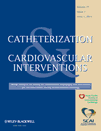Double-stent method†
An alternative technique to treat coronary artery aneurysms
Conflict of interest: The authors report no financial relationships or conflicts of interest regarding the content herein.
Abstract
Coronary artery aneurysm (CAA) is an uncommon and often incidental finding on coronary angiography but can present with symptoms related to myocardial ischemia. The most common etiology is atherosclerosis, accounting for over 50% of cases, but CAAs can also be congenital or secondary to percutaneous coronary artery revascularization procedures, inflammatory arterial diseases, connective tissue disorders, and perhaps drug-eluting-stent (DES) implantation. A current lack of uniform guidelines for their therapeutic management, especially in the setting of DES, leaves their optimum treatment somewhat controversial. Polytetrafluoroethylene-covered stents have gained popularity in recent years for percutaneous treatment of CAAs; however, their failure to endothelialize is associated with increased risk of thromboocclusive events. We describe two symptomatic patients presenting with large CAAs, one forming after DES implantation, that we treated using the double-stent method, in which one stent is placed within another. The intent is to reduce stent permeability across the aneurysm and promote blood stasis within it, thereby encouraging aneurysm thrombosis and meanwhile preserving the stents' ability to endothelialize. The immediate angiographic result revealed markedly reduced filling of the aneurysms and aneurysm thrombosis was later confirmed at follow-up. Both patients have remained asymptomatic during at least 9 months of follow-up. To the best of our knowledge, this is the first case report describing the use of the double-stent method as an alternative to treat CAAs percutaneously.© 2011 Wiley-Liss, Inc.




